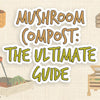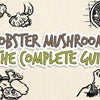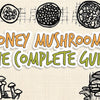Maitake Mushrooms: The Complete Guide
Grifola frondosa goes by many names although the most common would be maitake mushrooms. Maitake is a Japanese term for dancing mushroom. Legend has it that these mushrooms were once so rare that on finding them one would dance with joy hence the name. This mushroom has long been celebrated for its reported medicinal qualities and its culinary appeal.
Not Much Time? Skip To What You'd Like To Learn...
-
Maitake Mushroom Fun Facts
-
Top 5 Benefits Of Eating Maitake Mushrooms
-
Maitake Mushrooms As Medicine
-
How To Identify Maitake Mushrooms
-
False Lookalikes
-
Why Are They So Expensive?
-
Foraging and Where To Find Maitake Mushrooms
-
Harvesting Maitake Mushrooms in the Wild
-
How to Grow Maitake Mushrooms at Home
-
Processing Maitake Mushrooms
-
How to Preserve Maitake Mushrooms
-
Considerations and Recipes For Maitake Mushrooms

Maitake Mushrooms Fun Facts

-
Maitake mushrooms are also commonly known as hen of the woods, ram's head, sheep's head and among the Italian American communities in northeastern US referred to as the signorina mushroom.
-
The mushroom becomes inedible when older as it becomes too tough to eat.
-
In traditional Chinese and Japanese herbology, the mushroom is prized for its medicinal properties and has been in use among the native communities for ages.
-
The fungus is a polypore as it lacks gills on its undersides and instead, it has small pores for releasing its spores.
Top 5 Benefits of Eating Maitake Mushrooms

-
Slows Down Breast Cancer - Studies conducted by Memorial Sloan-Kettering Cancer Center have shown that consumption of maitake mushrooms helps in stimulating the immune systems of breast cancer patients. This, in turn, slows down the growth of tumor cells (link) (link).
-
Healthy Source of Vitamin D - Maitake mushrooms contain a dose of vitamin D which is crucial for healthy bone development as well as to maintain a robust nervous system. While your skin does produce vitamin D when exposed to sunlight, a maitake meal will help to replenish this critical vitamin.
-
Boosting Immune System - Grifola frondosa contains polysaccharides which help in enhancing the activity of immune system cells. This helps the body to fight off viral and bacterial infections before they can overpower the immune system.
-
Contains Antioxidants - Oxidation is a natural process which if left unchecked can result in rapid wearing out of body cells. Maitake mushrooms contain antioxidants which counter such chain reactions thus preventing further oxidation (link).
-
Controlling Diabetes - Maitake mushrooms are known to reduce blood glucose levels. The mushrooms also contain trace elements which play a significant role in preventing insulin resistance which is a condition which occurs when the body fails to respond to insulin regulation (link) (link).
(link)
Maitake Mushroom As Medicine

History - Maitake mushrooms are native in China and northeastern parts of Japan. As a result, the mushroom is highly coveted in traditional Japanese and Chinese herbology and for a long time has been used to treat hypertension and diabetes.
Alternative Ways To Consume - While Maitake mushrooms are best eaten cooked this might not always be possible especially for patients who find the taste too strong for them. In such a case the mushrooms can be dried in the sun and later on crushed into a fine powder. Alternatively, you can purchase the supplement extract which is mostly in powdered capsules.
Dosage and Consumption - The dosage and consumption levels will vary across various supplements. In such a case always adhere to the specified instructions and directions provided by the supplier. If you are not sure of the exact dosage or it's not indicated kindly contact your medical practitioner for further guidance.
Warnings:
-
Under no circumstance should you stop taking your prescription medication because you are consuming maitake mushrooms.
-
If you intended to take a daily maitake supplement it is encouraged first to seek the opinion of a qualified medical practitioner.
-
In rare cases, maitakes may cause mild allergic reactions. If you experience such a case, its recommended to halt further consumption of the supplement and contact a doctor
-
Maitake mushrooms have a cumulative effect. What this means is that you might not notice any changes in your health for the first few weeks or months. However, you should continue taking the supplement, and the results may be sporadic at first but should improve with time.
-
Its recommended to buy organically grown mushrooms, these are not only safer but have a higher nutrient content compared to commercially grown ones whereby you may run the risk of exposure to chemical disinfectants.
-
Be on the lookout for outrageous claims such as ‘cure for cancer' which some dubious companies use to try and drive their sales. Instead, go for supplements which offer factual information such as the amount of nutrients per portion.
-
You should always take maitake supplements or any other supplement with vitamin C. This is because the vitamin helps in increasing the absorption rate of polysaccharides as well as other trace particles.
How to Identify Maitake Mushrooms

Pores On The Hymenium: Instead of gills maitake mushrooms have pores on the underside of the cap (hymenium) these pores usually release the spores upon maturity.
Caps: Maitake mushrooms have offset caps which are indistinct with a whitish color that starts to fade to a lighter grey or yellow as they mature.
Spore Print: Maitake mushrooms have a white spore print.
Growth: Maitake mushrooms bloom in layers of caps which are curved like spoons all growing from a sizeable tuber-like structure located underground.
Odor and Taste: Maitake mushrooms have what some might call woodsy scent with an earthy and spicy flavor.
False Lookalikes

Maitake mushrooms don't have a lot of false lookalikes. In fact, the only mushrooms that you might confuse it for are mostly edible. However, most of these varieties offer little to no nutritional benefits.
Laetiporus Sulphureus - This species of bracket fungus is commonly known as the chicken of the woods, crab of the woods or sulphur shelf. Ultimately, it’s actually very easy to identify thanks to its striking golden-yellow shelf like fruit body. Laetiporus sulphureus is edible when young (link).
Bondarzewia Berkeleyi - Bondarzewia berkeleyi is commonly referred to as berkeley's polypore or the stump blossoms. It has shelf or fan-shaped caps that grow in overlapping clumps. These mushrooms come in various shades of white to pale grey, beige or pale yellow. Like laetiporus sulphureus, they are also edible.
Meripilus Sumstinei - These mushrooms are also known as the giant polypore or more commonly as the black-staining polypore. The conspicuous black stains especially when bruised make it rather easy to identify it from maitake mushrooms.
Why Are They So Expensive?

On average one pound of dried maitake mushrooms will set you back anywhere between $70-$80. These mushrooms are slightly pricey compared to the ordinary button mushrooms mainly due to the high demand. The majority of the mushrooms end up in the health supplements industry for further processing and extraction of polysaccharides.
Foraging and Where To Find Maitake Mushrooms

When foraging we would always recommend using mushroom knife for ease of use, and a clean cut. Interested in learning more about mushroom knives? Click Here For The Complete Guide To Mushroom Knives
Country: Maitake mushrooms prolifically grow in Northeastern regions of the United States, across Asia specifically in China and Japan where they are native, and in Europe where the weather conditions are right.
Climate: The best time to forage for maitake mushrooms is typically from late summer to early autumn, especially after the rains.
Environment: These mushrooms typically shy away from open grounds and are mostly found flourishing in the undergrowth of hardwood trees such as oaks where there's enough dead matter from the acorns as well as shade from the direct sunlight, you will find the mushrooms growing under oak trees or even other hardwoods.
WARNING: Never pick or eat wild mushrooms unless under the strict guidance of an expert.
Harvesting Maitake Mushrooms in the Wild
Usually maitakes grows to be large in size. Typically a single cluster can weigh as much as 20lb. This plus the fact that their stems usually grow thick means you have to bring along a heavy-duty mushroom hunting knife. Use the blade to cut off the steam near the base and trim off the lower fronds which are usually too mature for consumption.
If you’re interested in our favorite mushrooms knives. Check out our article Top 10 Mushroom Knives of 2019 here (link).
How to Grow Maitake Mushrooms at Home

The most recommendable way to grow healthy maitake mushrooms at home is by recreating their natural habitat. Of course, this doesn’t mean you have to have an oak tree in your backyard, instead focus on the conditions found underneath one. It's also important to note that it takes quite a while before the maitake grows and matures to provide a good yield.
Want to know our Top 10 Mushrooms Growing Kits? We have a full and comprehensive guide to the best growing kits and considerations before buying one too! Check out our Top 10 Mushroom Growing Kits Here.
Here are the steps to follow:
1. Log preparation - Get a seasoned oak log at least 6 inches in width and 3 feet in length. Submerge it in cold water and allow it to soak for at least 6 hours for maximum water absorption.
2. Drilling - Using a drill fitted with a five-sixteenths inch bit, drill holes along the log. Typically, 25 to 30 holes should be enough and ensure that they are at least 1.5 inches deep.
3. Inoculation - This step involves introducing the maitake mushroom spawn to the log. Use 1-inch long oak dowels inoculated with spawns for each hole. You can purchase these pre-inoculated dowels online.
4. Sealing - Heat up a quarter pound of cheese wax in a skillet until it melts. Using a pastry brush apply the wax on the log to seal it completely, this serves to keep off insects and other fungi from contaminating the wood.
5. Storing and Irrigating - For the next six months, you should keep the log in a damp outdoor area suspended above the ground. This helps to keep off foreign fungus from colonizing. You should water the log every two weeks to keep it moist at all times.
6. Pinning - When the maitake mushroom pins begin to grow, you should shock the spawn into growth by soaking the log in ice water for 24 hours.
7. Cropping - After the pinning is done, the mushrooms should gradually fruit although the rate may be slow. You can begin harvesting when the first clusters are sizeable enough. After each harvest, it's recommended to wait at least six weeks for the clusters to regrow.
Inspired by SFGate (link).
Interested in growing mushrooms at home? Check out our Top 10 Growing Kits of 2019 here (link).
Processing Maitake Mushrooms

Cleaning: Maitake mushrooms require a more rigorous cleaning method than other mushrooms due to the fact that they grow in clusters and therefore they collect more dirt in between the crevices. Set the mushroom in a large bowl and pick off any leaves, twigs or acorns that might be clinging onto the mushrooms.
Brushing: Using a soft bristled brush dust off any soil particles that might be on the mushrooms.
Cutting and Stem Removal: Using a sharp knife separate the base as well as a majority of the mature stems attached to it as these parts are too hard to chew. Also, isolate any bruised or moldy sections and discard.
Wiping: Using damp paper towels wipe each piece until they are clean to cook. Avoid soaking as this will make the mushrooms water clogged and slimy
How To Preserve Maitake Mushrooms

Due to the fact that maitake mushrooms bloom perennially, there's the need to preserve the extra mushrooms after a bounty harvest. There are various methods of preserving them thanks to the fact that they don't have gills, therefore, they are less likely to absorb moisture during storage which usually renders mushrooms soggy.
Check out our full article on mushroom storage here (link).
Freezing:
This is the best way to save them for future use. Basically, you can freeze them when they are either raw, sautéd or boiled. To freeze these mushrooms just spread them on a cookie sheet and freeze, after they are frozen transfer them into a zip top bag or airtight plastic container. This ensures that they remain separate during the frozen storage where they can last for up to 6 months.
If you’re interested in freezing mushrooms, check out our article here (link).
Pickling:
You can use the pickling recipe mentioned in the cooking section to make pickled maitake mushrooms. The jars are then kept in the fridge whereby you can keep them for up to one year without any changes in quality.
For a full guide on pickling mushrooms, check out our blog post here (link).
Dehydrating:
This process involves using a dehydrator to evaporate all the moisture content in maitake mushrooms before they are stored in sealed jars in your pantry. Dehydrated mushrooms are great for making soups, mushroom tea or stews. However, they do lose some taste, texture, and nutrition in the process.
Check out our article on drying mushrooms here (link).
Recipes For Maitake Mushrooms
Maitake mushrooms are relatively easy to cook as they do not require any special preparation techniques.
Considerations:
-
Avoid the stems as they are usually too chewy and often have a bitter taste.
-
Always slice the mushrooms into bite size pieces, this allows you to inspect them and get rid of any grit as well making them easier to cook thoroughly.
Cream of Maitake Soup
Inspired by Pray Cook Blog (link)
Ingredients:
2 lbs maitake mushroom, cleaned and sliced
1/2 tsp freshly cracked pepper
6 cups vegetable stock
1 1/2 tsp salt
1 lb potatoes, chopped
1 lb carrots, chopped
2 tbsp lemon juice
2 tbsp butter
2 tbsp olive oil
1 onion, chopped
5 garlic cloves, minced
2 bay leaves
1 cup heavy cream
1 cup white wine
1 tsp sage minced
Directions:
1. Heat a heavy soup pot over medium to high heat and add olive oil and butter to melt.
2. Add garlic and onions, sauté until golden brown and add the maitake mushrooms. Cook for 10 minutes.
3. Add carrots, potatoes, and pepper. Sauté for 10 minutes.
4. Add stock, salt to taste, bay leaves, and sage and bring to a boil for about 20 minutes.
5. Remove the bay leaves.
6. Puree the soup until smooth then add lemon juice and white wine, simmer for another 5 minutes
7. Stir in the cream.
8. Serve while hot.
Pickled Maitakes
Inspired by Forager Chef (link)
Ingredients:
1 lb young maitake mushrooms, cleaned and sliced
1 cup vinegar
2 dried bay leaves
3 cups of water
fresh thyme
2 tsp salt
2 large garlic cloves, minced
Directions:
1. In a large pot bring the water, garlic, bay leaves, thyme, and salt to boil.
2. Add the maitake mushrooms, cover and boil until they are wilted and thoroughly cooked.
3. Add vinegar and simmer for 5 minutes.
4. Pack your canning jars with the maitake mushrooms and top off with pickling liquid.
Breaded Maitake Mushrooms
Ingredients:
6 oz maitake mushrooms, cleaned and sliced
2 garlic cloves crushed
3 cup panko breadcrumbs
salt and pepper
1 tsp fresh thyme chopped
1 tsp crushed red pepper
2 tbsp cooking oil
3 tbsp butter
Directions:
1. In a large skillet add the oil and garlic and sizzle over medium heat until the garlic turns brown.
2. Add the maitake mushrooms and butter. Cook until they are caramelized.
3. Season with salt and pepper to taste.
4. Add breadcrumbs, thyme and continue stirring regularly over low heat.
5. When the breadcrumbs turn golden brown remove the skillet from the heat and add dried chili.
6. Serve while hot.
Green Bell Peppers Stuffed with Maitake Mushrooms
Inspired by Cookpad
Ingredients:
6 oz maitake mushrooms cleaned and sliced
6 green bell pepper
1 tbsp sesame oil
1 tsp sake
50g ground chicken breast, cooked
1 tsp soy sauce
1 tsp butter
Directions:
1. Mix the maitake mushrooms, butter, and ground chicken in a bowl and set aside.
2. Using a pair of kitchen scissors, cut around the stem end of the peppers and remove the seeds together with the stem.
3. Stuff the chicken and maitake mixture into the prepared peppers.
4. In a pan add the sesame oil over medium heat and place the peppers with the stuffed side facing downwards. Cook until browned.
5. Turn the peppers on their sides, add the soy sauce and cook over low heat. Cook while stirring gently to ensure that all sides are evenly cooked.
6. Serve while still hot.
Grilled Maitake Mushrooms
Inspired by Bon Appetit (link)
Ingredients:
2 lb maitake mushrooms, cleaned and sliced into chunks
1 tsp smoked sea salt
1 tsp rosemary leaves, chopped
4 green onions, sliced thinly
salt and pepper to taste
extra virgin olive oil
Directions:
1. Place the maitake mushrooms on a rimmed baking sheet. Drizzle the oil until the mushrooms are well coated, season with salt and pepper and set aside to allow them to absorb as much oil.
2. Set a grill pan over high heat. Add the mushrooms and cook until charred, flip over and cook the other side.
3. Continue grilling until the mushrooms are nicely colored.
4. Transfer the mushrooms onto a platter and garnish with green onion slices, smoked sea salt, and chopped rosemary.
5. Serve while still hot.






